In the vibrant and flavorful world of Filipino cuisine, there’s no better way to start the day than with a hearty and delicious breakfast. Mangaon Ta! —which means “Let’s eat!” in Filipino—is an exclamation that captures the joy and excitement of sharing a meal. This article is dedicated to bringing you a collection of delightful breakfast ideas Filipino style, to inspire your mornings and satisfy your cravings.
Filipino breakfasts are known for their diverse flavors, vibrant colors, and unique combinations of ingredients. From savory dishes that awaken your taste buds to sweet treats that indulge your senses, the Filipino breakfast experience celebrates the country’s culinary heritage. Whether you’re a fan of classic favorites or eager to explore new flavors, this article will give you a wealth of ideas to elevate your breakfast game.
Get ready to discover a range of mouthwatering dishes, from traditional favorites passed down through generations to modern interpretations that infuse creativity and innovation. We’ll delve into the essence of Filipino breakfast cuisine, highlighting the ingredients, techniques, and cultural influences that make it so unique.
Join us on this culinary adventure as we explore the world of breakfast ideas, Filipino style. From the sizzle of a perfectly cooked tapsilog to the comforting warmth of champorado, prepare to awaken your senses as we embark on a delicious journey together.
Tapsilog: The classic Filipino breakfast
Ah, Tapsilog! Get ready to embark on an irresistible adventure through the heart and soul of Filipino breakfast cuisine. Let me paint a picture for you: the gentle sizzle of marinated beef, the tantalizing aroma of garlic-infused rice, and the vibrant golden hue of a perfectly cooked sunny-side-up egg. Tapsilog, the iconic trio of tapa, sinangag, and itlog, encapsulates the essence of Filipino breakfasts—a celebration of flavors, traditions, and the joy of starting the day with a satisfying meal.
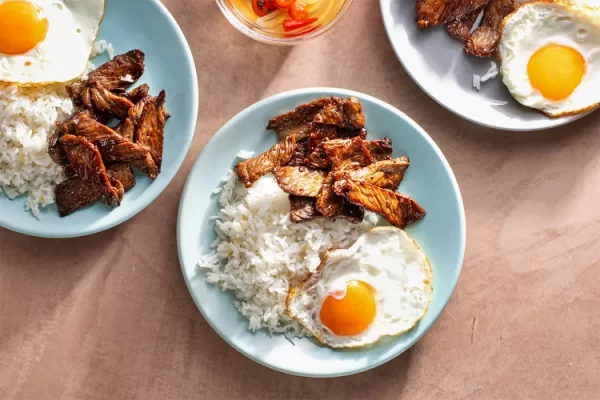
Let’s first break down the three essential components that create a symphony of flavors:
Tapa: The star of the show, tapa is thinly sliced or shredded marinated beef that’s bursting with savory, sweet, and sometimes tangy flavors. The beef is typically marinated in soy sauce, calamansi (a local citrus fruit), garlic, sugar, and other secret ingredients, which vary from one recipe to another. The marinade infuses the meat with its distinct taste and tenderizes it to perfection. Once marinated, the beef is fried or grilled until it’s beautifully caramelized, creating a delightful contrast of flavors and textures.
Sinangag: Sinangag refers to garlic fried rice—a staple in many Filipino breakfasts. Fragrant and flavorful, it’s made by sautéing leftover rice with minced garlic in oil or rendered fat. The result is a heavenly medley of aromatic garlic and perfectly crispy rice grains. Sinangag adds a satisfying and comforting element to tapsilog, providing a delicious canvas for the other components to shine.
Itlog: Last but not least, we have itlog, which simply means egg. In tapsilog, the egg is commonly served sunny-side-up or over-easy, allowing the rich, creamy yolk to intermingle with the other components. The egg’s silky texture and delicate flavors complement the savory tapa and the fragrant Sinangag, creating a delightful harmony that bursts with every bite.
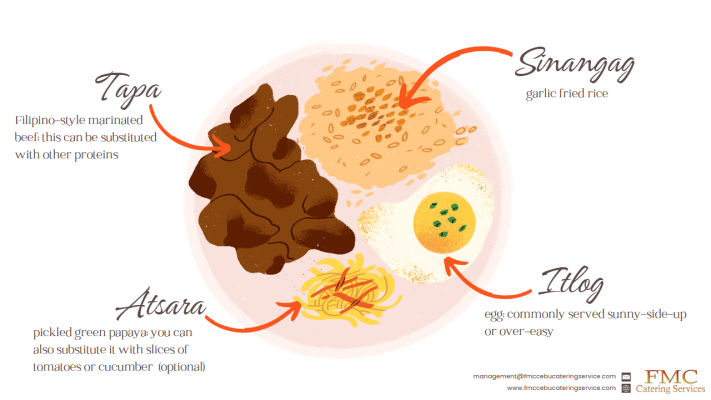
Variations of tapsilog
Tapsilog is undoubtedly a breakfast favorite that has captured the hearts and palates of many. But did you know that within the realm of Tapsilog lies a treasure trove of delicious variations? Let’s embark on a flavorful journey as we explore some exciting twists on this beloved breakfast dish.
Longsilog: Longsilog puts a delightful spin on tapsilog by replacing the traditional tapa with longganisa, a Filipino sausage bursting with flavor. This juicy and slightly sweet sausage, often made from ground pork mixed with various seasonings and spices, adds a unique and irresistible dimension to the dish.
Tosilog: For those who crave a touch of sweetness in their morning meal, Tosilog is the perfect choice. Tocino, a Filipino-style cured pork, takes center stage in this variation. The pork is marinated in a sweet and savory blend of sugar, soy sauce, garlic, and other secret ingredients, resulting in tender, caramelized slices that will make your taste buds dance with joy.
Bangsilog: Are you a seafood lover looking for a unique breakfast experience? Enter bangsilog, where tapa is replaced by bangus, or milkfish—a popular fish in Filipino cuisine. The Bangus is marinated in a tangy and flavorful mixture, then fried to perfection.
Chicksilog: If you’re seeking a lighter and leaner alternative, Chicksilog is the way to go. The beef tapa is swapped out in this variation for tender and succulent chicken, marinated in a savory blend of herbs, spices, and sauces. Grilled or pan-fried to perfection, the chicken brings a deliciously wholesome taste.
Adobosilog: Prepare to tantalize your taste buds with the fusion of two beloved Filipino dishes: tapsilog and adobo (sometimes referred to as the Philippines’ national dish!). Adobosilog features a marinated and slow-cooked pork or chicken, boasting the rich flavors of soy sauce, vinegar, garlic, and spices instead of the traditional tapa.
We know it might be overwhelming to pick which silog to have, don’t worry! We’ve made a guide with the different silog variations.

These variations of Tapsilog showcase the versatility and creativity that Filipino breakfast cuisine has to offer. Each presents a unique combination of flavors and ingredients, allowing you to tailor your breakfast experience to suit your preferences. Whether you’re a fan of the classic tapa or eager to explore new twists, these variations provide a delightful journey through the diverse and vibrant world of Filipino breakfasts.
Champorado: A sweet start to the day
In Filipino breakfasts, one dish stands out for its unique combination of sweetness, warmth, and nostalgia—champorado. This beloved chocolate rice porridge has been a comforting morning staple for generations, delighting both young and old with its rich flavors and satisfying texture.
Champorado is the epitome of indulgence and comfort, making it the perfect treat to kickstart your day. Traditionally made by simmering glutinous rice with cocoa powder and sweetened with sugar, this dish has a velvety consistency resembling a thick, luscious chocolate pudding. The deep, chocolaty aroma fills the kitchen, enveloping your senses and beckoning you to take that first heavenly spoonful.
The flavor profile of champorado is a symphony of sweet and earthy notes, with a hint of bitterness from the cocoa. It perfectly balances the rice’s natural sweetness and the chocolate’s decadence. The smooth and creamy texture adds to the overall experience, providing a comforting feeling as it warms you from within. Each spoonful is like a cozy embrace, transporting you to pure bliss.
Preparing Champorado is surprisingly simple, requiring just a few pantry staples and patience. Here’s a basic recipe to get you started:
Ingredients:
- 1 cup glutinous rice
- 4 cups water
- 1/2 cup tablea or cocoa powder
- 1/2 cup sugar (adjust according to your preferred sweetness)
- Pinch of salt
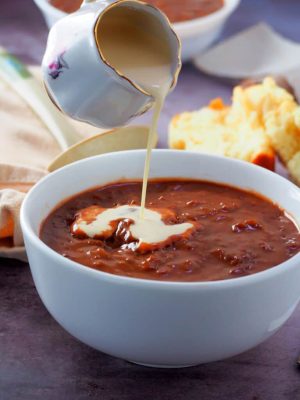
Instructions:
- In a large saucepan, combine the glutinous rice and water. Bring to a boil over medium heat.
- Reduce the heat to low and simmer, stirring occasionally to prevent sticking, for about 20-25 minutes or until the rice is cooked and has absorbed most of the water.
- Whisk the tablea or cocoa powder, sugar, and salt in a small bowl until well combined.
- Gradually add the cocoa mixture to the cooked rice, stirring continuously to ensure it is fully incorporated.
- Continue cooking the mixture over low heat, stirring occasionally, for 10-15 minutes or until the Champorado reaches your desired consistency.
Champorado toppings suggestion
Let’s take your Champorado to the next level with delectable toppings. Here are a few suggestions:
Condensed Milk: Drizzle a generous swirl of condensed milk over your bowl of Champorado for an extra creamy and sweet touch. The contrast between the rich chocolate and the silky sweetness of the milk is simply divine.
Tuyo (Dried Fish): Pair your Champorado with some crispy fried tuyo for a delightful contrast of flavors. The saltiness of the tuyo adds a savory element that beautifully balances the sweetness of the chocolate.
Fried Saba Banana: Slice a ripe saba banana and fry it until golden and caramelized. Top your Champorado with these sweet banana slices for a tropical twist to transport your taste buds to paradise.
Toasted Pinipig: Toasted pinipig, pounded young rice grains, provide a delightful crunch and nutty flavor to your Champorado. Sprinkle a handful over the top for a textural contrast that elevates each spoonful.
Whether you enjoy champorado as a nostalgic reminder of childhood or as a comforting indulgence to start your day, this sweet rice porridge offers a unique and delightful breakfast experience.
Pandesal: The beloved Filipino bread
When it comes to Filipino breakfast culture, you cannot overlook the significance of pandesal. This iconic bread, with its soft and pillowy interior and golden-brown crust, has won the hearts and appetites of Filipinos for generations.
Pandesal holds a special place in Filipino breakfast and is considered a staple in many households. Its name, derived from the Spanish words “pan de sal,” meaning “bread of salt,” refers to its unique slightly salty taste that perfectly balances the sweetness of its dough. As the sun rises, the aroma of freshly baked pandesal wafts through the streets, signaling the start of a new day and enticing everyone to gather around the breakfast table.
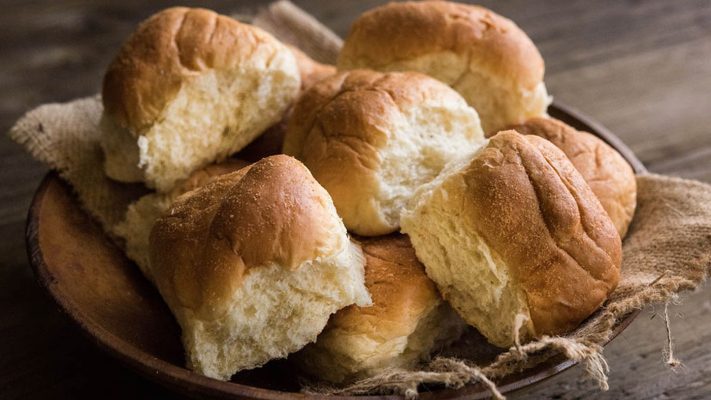
Pandesal pairings suggestions
Pandesal alone is good, but you can improve it by pairing it with creative fillings, spreads, and beverages. Here are a few delightful suggestions:
Classic Margarine and Sugar: Slice pandesal in half and spread a generous amount of margarine on each side. Sprinkle granulated sugar over the spread surfaces for a simple yet satisfying combination.
Cheese and Ham: For a savory twist, fill your pandesal with slices of cheese and ham. Place them in the oven or toaster to melt the cheese slightly for a gooey and comforting treat.
Peanut Butter: This one’s a classic. Spread a layer of creamy peanut butter on one side of the pandesal, and if you want to level it up, top it with thinly sliced bananas. This combination offers a delightful blend of creamy, nutty, and fruity flavors.
When it comes to beverage pairings, pandesal pairs well with a variety of choices. Here are a few options to complement the flavors of this beloved Filipino bread:
Coffee: A cup of freshly brewed coffee is a classic accompaniment to pandesal. The rich and robust coffee flavors beautifully complement the bread’s slightly salty and sweet taste. Whether you prefer black coffee, a creamy latte, or a frothy cappuccino, the warmth and aroma of a well-brewed cup will enhance your pandesal experience.
Milk: A glass of cold or warm milk is an excellent choice for a milder beverage. The creamy and smooth texture of milk provides a refreshing contrast to the soft and fluffy pandesal.
Tsokolate: To truly embrace the Filipino breakfast experience, pair your pandesal with a traditional Filipino hot chocolate known as tsokolate. Made from finely ground tablea, this rich and thick chocolate drink offers a deep and authentic flavor that perfectly complements the taste of pandesal. Prepare it by dissolving the tablea in hot water or milk and stirring until smooth. Sip on this heavenly beverage while savoring each bite of pandesal for a truly indulgent breakfast.
The beauty of pandesal lies in its versatility. Explore different fillings, spreads, and beverage pairings to create your unique breakfast experience. Whether you prefer sweet or savory combinations, pandesal offers endless possibilities to satisfy your taste buds and start your day on a delicious note.
Regional Specialties: Breakfast Gems from Different Filipino Regions
The diverse culinary landscape of the Philippines extends to its breakfast culture, where each region boasts unique and flavorful morning dishes. Let’s embark on a gastronomic journey as we explore some breakfast gems from different Filipino parts, featuring beloved dishes like Vigan longganisa, puto bumbong, and danggit. Discover the distinct flavors and ingredients that make these regional specialties genuinely exceptional.
Vigan Longganisa: From the North Comes Savory Delight
Hailing from the picturesque city of Vigan in Ilocos Sur, Vigan longganisa is a delicacy that captures the essence of northern Filipino cuisine. It is made from ground pork, garlic, vinegar, and a medley of spices; these plump sausages offer a burst of savory flavors. The unique combination of garlic and local spices gives Vigan longganisa its distinct taste, setting it apart from other types of longganisa in the country. Served with garlic rice, vinegar dipping sauce, and a side of sunny-side-up eggs, Vigan longganisa makes for a hearty and satisfying breakfast that showcases the rich flavors of the North.

Puto Bumbong: A Delicacy from the Festive South
In the southern region of the Philippines, particularly during the Christmas season, puto bumbong takes center stage. This purple-hued rice cake is made from a special glutinous rice called “pirurutong,” which is soaked overnight, ground, and steamed in bamboo tubes. The resulting puto bumbong has a distinct chewy texture and a subtly sweet and earthy flavor. Traditionally served with grated coconut, butter, and muscovado sugar, this festive treat transports you to the joyous celebrations of the South, leaving a lasting impression on your taste buds.
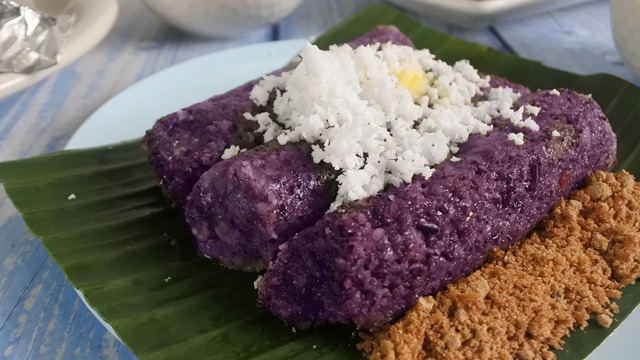
Danggit: Sunrise Delights from the Visayas
As the sun rises over the Visayan islands, a beloved breakfast favorite emerges—danggit. This sun-dried and salted rabbitfish, locally known as “danggit,” is a delicacy that brings a delightful crunch to the morning meal. With its golden-brown color and flavorful taste, danggit is usually fried to perfection, accompanied by garlic rice and vinegar dipping sauce, or you can also use it as a topping for your hot champorado. The combination of its crispy texture and savory notes showcases the coastal flavors of the Visayas and adds a delightful touch of the sea to your breakfast table.
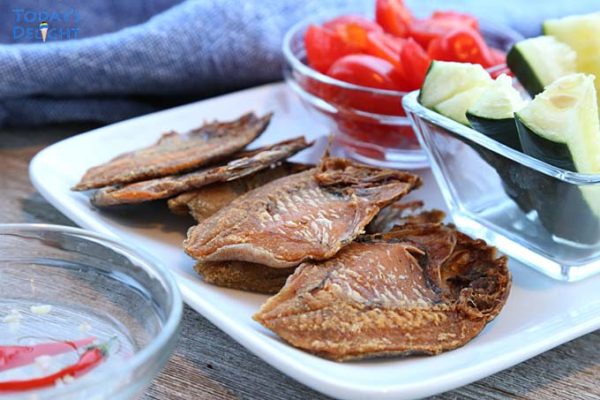
Tips for a Perfect Filipino Breakfast Experience
To truly immerse yourself in the delightful world of Filipino breakfast, it’s not just about the dishes you prepare—it’s also about creating an authentic ambiance that transports you to the heart of the Philippines. Here are some tips to enhance your breakfast experience and make it feel like you’re having a delightful morning meal in a cozy Filipino home.
Set the Table: Start by setting a warm and inviting table. Use a vibrant tablecloth or placemats with Filipino-inspired patterns to infuse a touch of Filipino culture into your breakfast nook. Add a centerpiece like a vase of fresh flowers or a woven basket filled with tropical fruits for a vibrant and inviting atmosphere.
Utensils and Tableware: Opt for traditional Filipino utensils and tableware if you have them. Use wooden spoons, forks, or banana leaves as makeshift plates for an authentic touch. If you don’t have these items, no worries! Use your regular utensils and plates, but consider adding a few small Filipino touches like colorful napkins or handcrafted coasters.
Aromas and Scents: The smell of food cooking is an integral part of any breakfast experience. To capture the essence of a Filipino kitchen, infuse your space with the aroma of garlic, onions, and spices. Sauté some garlic in a pan or simmer aromatic herbs like pandan or calamansi leaves. These scents will transport you to a traditional Filipino home and awaken your appetite.
Traditional Filipino Beverages: Pair your Filipino breakfast dishes with authentic Filipino beverages. Start your morning with a cup of strong barako coffee—a local variety known for its robust flavor and invigorating kick. If you prefer something sweeter, indulge in a cup of tsokolate, a rich and velvety hot chocolate made from local tablea. Sipping on these traditional Filipino beverages adds more authenticity to your breakfast experience.
Conclusion
Embrace the vibrant flavors of Filipino cuisine and try these breakfast ideas in your kitchen. Let your taste buds dance with joy as you savor the unique combinations of ingredients and experience the warmth and comfort that Filipino breakfasts bring.
But our culinary adventure continues. The Filipino cuisine is a treasure trove of delights waiting to be explored. From savory dishes to delectable desserts, a world of flavors is waiting for you to discover.
In the spirit of Filipino hospitality and togetherness, may your breakfasts be filled with joy, delicious flavors, and memorable moments shared with loved ones. And as you continue your culinary exploration, may you find more culinary delights that make your taste buds sing with delight.
Mangaon Ta!
If you want to host a memorable event featuring a delightful Filipino breakfast, we’ve got you covered! Contact us today, and our team will work closely with you to plan the perfect menu for you and your guests.

